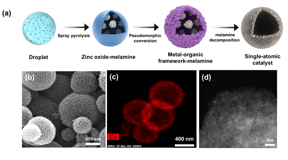Home > Press > Development of high-durability single-atomic catalyst using industrial humidifier: Identification of the operating mechanism of cobalt-based single-atomic catalyst and development of a mass production process. Utilization for catalyst development in various fields including fuel
 |
| (a) single-atomic catalyst synthesis process using humidifier method, (b) SEM image, (c) cobalt element mapping image, (d) high-resolution STEM image of cobalt single-atomic catalyst
CREDIT Korea Institute of Science and Technology (KIST) |
Abstract:
Fuel cell electric vehicles (FCEVs) are an eco-friendly means of transportation that will replace internal combustion locomotives. FCEVs offer several advantages such as short charging time and long mileage. However, the excessive cost of platinum used as a fuel cell catalyst leads to limited supply of FCEVs. There has been extensive research on non-precious metal catalysts such as iron and cobalt to replace platinum; however, it is still challenging to find substitutes for platinum due to low performance and low stability of non-precious metal catalysts.
Development of high-durability single-atomic catalyst using industrial humidifier: Identification of the operating mechanism of cobalt-based single-atomic catalyst and development of a mass production process. Utilization for catalyst development in various fields including fuel
Sejong, Korea | Posted on May 13th, 2022
The research team led by Dr. Sung Jong Yoo of the Hydrogen·Fuel Cell Research Center at Korea Institute of Science and Technology (KIST, President Seok Jin Yoon) conducted joint research with professor Jinsoo Kim of Kyung Hee University and professor Hyung-Kyu Lim of Kangwon National University; they announced that they have developed a single atomic cobalt-based catalyst with approximately 40% improved performance and stability compared to contemporary cobalt nanoparticle catalysts.
Conventional catalysts are typically synthesized via pyrolysis, wherein transition metal precursors and carbon are mixed at 7001000℃. However, due to metal aggregation and a low specific surface area, the catalysts obtained through this process had a limited activity. Accordingly, researchers have focused on synthesizing single-atomic catalysts; however, previously reported single-atomic catalysts can only be produced in small quantities because the chemical substances and synthesis methods used varied depending on the type of the synthesized catalyst . Therefore, research has focused on performance improvement of the catalyst rather than the manufacturing process.
To address this problem, the spray pyrolysis method was implemented using an industrial humidifier. Droplet-shaped particles were obtained by rapidly heat-treating the droplets obtained from a humidifier. This can enable mass production through a continuous process, and any metals can be easily produced into particles. The materials used for the synthesis of metal particles should be water-soluble because the particles are made through an industrial humidifier.
It was confirmed that the cobalt-based single-atomic catalysts developed through this process exhibit excellent stability as well as fuel cell performance and are 40% superior compared to conventional cobalt catalysts. Cobalt-based catalysts also cause side reactions in fuel cells; however, computational science has shown that catalysts manufactured via spray pyrolysis lead to forward reactions in fuel cells.
Dr. Yoo clarified, Through this research, a process that can enable considerable improvement in the mass production of cobalt-based single-atomic catalysts has been developed, and the operating mechanism of cobalt-based catalysts has been elucidated via close analyses and computational science. These results are expected to serve as indicators for future research on cobalt catalysts. They also added, We plan to expand the scope of future research to explore not only catalysts for fuel cells, but also environmental catalysts, water electrolysis, and battery fields.
####
About National Research Council of Science & Technology
KIST was established in 1966 as the first government-funded research institute to establish a national development strategy based on science and technology and disseminate various industrial technologies to develop major industries. KIST is now raising Korean science and technology status through world-leading innovative research and development. For more information, please visit our website at https://eng.kist.re.kr/kist_eng_renew/
This research was supported by the KIST Institutional Program, Climate Change Technology Development Project Nano·Material technology development project, which are funded by the Ministry of Science and ICT (Minister, Hyesook Lim) The research results were published in the latest issue of Applied Catalysis B: Environmental (IF: 19.503 JCR top 0.926%), an international journal in the field of energy and the environment.
For more information, please click here
Contacts:
Mira Lee
National Research Council of Science & Technology
Office: 44-287-7374
Cell: 01-9800-1732
Expert Contacts
Dr. Yoo, Sung Jong
Korea Institute of Science and Technology (KIST)
Office: +82-2-958-5260
Lee, Yeeun (PR Department)
Korea Institute of Science and Technology (KIST)
Office: +82-2-958-6929
Copyright © National Research Council of Science & Technology
If you have a comment, please Contact us.
Issuers of news releases, not 7th Wave, Inc. or Nanotechnology Now, are solely responsible for the accuracy of the content.
News and information
![]()
Engineering piezoelectricity and strain sensitivity in CdS to promote piezocatalytic hydrogen evolution May 13th, 2022
![]()
New nanomechanical oscillators with record-low loss May 13th, 2022
![]()
Small microring array enables large complex-valued matrix multiplication May 13th, 2022
Chemistry
![]()
Flexible quantum sieve made at TU Dresden filters the fuel of Starship Enterprise April 15th, 2022
![]()
Photocatalysts with built-in electric field helps to remove pollutants from water April 15th, 2022
Possible Futures
![]()
Engineering piezoelectricity and strain sensitivity in CdS to promote piezocatalytic hydrogen evolution May 13th, 2022
![]()
New nanomechanical oscillators with record-low loss May 13th, 2022
![]()
Small microring array enables large complex-valued matrix multiplication May 13th, 2022
Discoveries
![]()
New nanomechanical oscillators with record-low loss May 13th, 2022
![]()
Small microring array enables large complex-valued matrix multiplication May 13th, 2022
Announcements
![]()
Engineering piezoelectricity and strain sensitivity in CdS to promote piezocatalytic hydrogen evolution May 13th, 2022
![]()
New nanomechanical oscillators with record-low loss May 13th, 2022
![]()
Small microring array enables large complex-valued matrix multiplication May 13th, 2022
Interviews/Book Reviews/Essays/Reports/Podcasts/Journals/White papers/Posters
![]()
Lightening up the nanoscale long-wavelength optoelectronics May 13th, 2022
![]()
On-Chip Photodetection: Two-dimensional material heterojunctions hetero-integration May 13th, 2022
![]()
Engineering piezoelectricity and strain sensitivity in CdS to promote piezocatalytic hydrogen evolution May 13th, 2022
![]()
New nanomechanical oscillators with record-low loss May 13th, 2022
Energy
![]()
Engineering piezoelectricity and strain sensitivity in CdS to promote piezocatalytic hydrogen evolution May 13th, 2022
![]()
USTC found a pathway to high-quality ZnSe quantum wires April 8th, 2022
![]()
Three dimensional Mn-doped NixSy/Ni2P and Mn-doped Ni2O3/Ni2P nanosheets as efficient electrocatalysts for alkaline overall water splitting April 8th, 2022
Water
![]()
The future of desalination? A fast, efficient, selective membrane for purifying saltwater May 13th, 2022
![]()
The deformation of the hydrogel is used to measure the negative pressure of water April 22nd, 2022
![]()
Photocatalysts with built-in electric field helps to remove pollutants from water April 15th, 2022
Battery Technology/Capacitors/Generators/Piezoelectrics/Thermoelectrics/Energy storage
![]()
Engineering piezoelectricity and strain sensitivity in CdS to promote piezocatalytic hydrogen evolution May 13th, 2022
![]()
Achieving higher performance with potassium ion battery April 15th, 2022
![]()
Interdisciplinary team studies challenges and prospects of lithium-CO2 dioxide batteries April 8th, 2022
Fuel Cells
![]()
Scavenger nanoparticles could make fuel cell-powered vehicles a reality April 1st, 2022
![]()
Graphene gets enhanced by flashing: Rice process customizes one-, two- or three-element doping for applications March 31st, 2022
![]()
Activating lattice oxygen in perovskite oxide to optimize fuel cell performance December 17th, 2021










